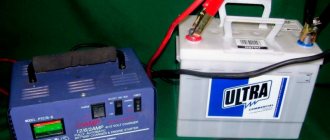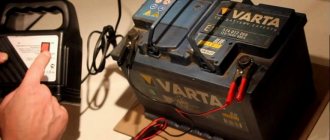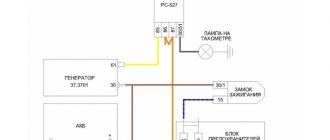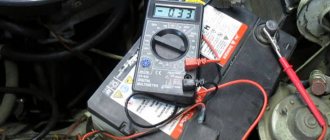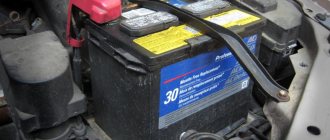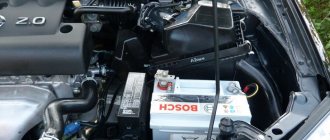17.05.2019
| (No votes) |
Issues discussed in the material:
- How does a car battery work?
- How long does it take to charge a battery at constant current?
- How long does it take to charge a car battery at constant voltage?
- What are the safety rules when charging a battery?
Before use, each battery must be carefully prepared, otherwise you risk encountering a variety of troubles. This device contains dangerous chemicals inside that can harm your car. It is for this reason that it is important to know how long to charge your car battery.
How does a car battery work?
In winter, owners are faced with the acute issue of charging their car’s battery, because starting in the cold can instantly discharge the battery. Often, old batteries are simply handed over to buyers and new ones are purchased, but there are also vehicle owners who recharge them for further use. Modern car batteries can last you up to 5 years, but this is only if you use them correctly. Otherwise, for example, if the current is supplied incorrectly or the charging time is incorrect, the battery will quickly fail.
To correctly approach charging a car battery, you first need to understand the special terms. For example, capacity is measured in ampere-hours, that is, if you see the inscription 60 A on your battery, therefore, it delivers exactly this amount of charge per hour. In addition, if the load drops to 30 A, it already takes two hours to release a charge of 60 A, etc. It turns out that depending on how many amperes are at the output, it takes a different amount of time to charge the car battery at a certain speed. If you don't take this point into account, you'll be in trouble.
It so happens that the normal voltage of a car battery is considered to be 12 volts, however, this is not entirely true. This value is average. Typically, a working battery has a charge of 12.6–12.7 V. This is a fully charged car battery.
We recommend
“Normal car battery voltage: numbers you need to memorize” Read more
At 12 V, the battery charge will be approximately 50%. It's quite possible to travel with it. After all, with a fully functioning system in your car, the charge will quickly reach 100%. Separately, it must be emphasized that a charge indicator of 11.5–11.6 V indicates the so-called “deep charging”. This has an extremely adverse effect on the car battery: a process of “sulfation” of the internal lead plates occurs, which significantly reduces the battery capacity. In some cases, the car simply may not start.
Therefore, to function properly and deliver 60 amps per hour, your car battery needs to have a charge of 12.7 V. After use, it will drop to 11.6 V and will need to be recharged. And so the process repeats in a circle.
Rechargeable batteries come in two types.
- The first is maintenance-free batteries. A special electrolyte is sealed inside them, which in any case cannot evaporate. And if this happens, then it turns into steam and condenses again in the same place. With this type of car batteries you will not have any problems.
- The second type is rapidly becoming a thing of the past, because it requires special maintenance. Such batteries do not have a strictly sealed case, and the liquid from them can evaporate freely. This type of battery is considered very problematic; it requires some care and constant recharging.
What needs to be done to charge the second type battery? First, remove all condensation and dirt from the surface. To do this, you will need a rag and a solution of regular soda. Wipe the entire top of the battery with this product. Pay close attention to cleaning the contacts, because if your battery has a screw-on cover, when it slides, all the external dirt will immediately get inside, which is harmful to the operation of the battery.
After unscrewing the cap, check the electrolyte level. If it does not cover the plates, then you need to add distilled water. It will prevent heating of the lead plates and rapid wear of the car battery.
In addition, measure the density of the electrolyte. Ideally, for a fully working battery it is 1.26–1.30 g/cm3.
What does the voltage indicator depend on?
There are several reasons why the battery voltage drops to a minimum:
Check for current leakage.
- natural wear and tear, when the battery has exhausted its life and is not able to maintain normal voltage values, like a new one;
- breakdown of the car's generator - as a result, when the engine is running, the IP does not receive the maximum charge necessary to restore capacity;
- current leakage in the vehicle's on-board network. In this case, even a new battery will not charge normally and will not be able to produce the operating starting current required for the starter. The cause of the leak can be any electrical equipment connected to a single network.
All causes of voltage drop, except for natural wear and tear, can be eliminated; just visit an electrician.
Sometimes the reason for battery discharge is frequent short-term trips, for example, when the place of work is 3-5 km from home. In this case, the generator may not have time to restore capacity. The solution is regular trips (once a week) lasting 30-40 minutes or recharging using a recovery device. Also, the voltage will drop if you do not turn off the lights or listen to the radio for a long time. Even one electrical appliance turned on with the engine off will completely drain the battery in a few hours.
Overcharging the battery when the maximum value exceeds 13 V is also dangerous. As a rule, the reason is a malfunction of the generator. Sometimes drivers deliberately overcharge the battery to increase the density of the electrolyte. If the voltage is higher than normal, the power supply resource is reduced.
Among the reasons for overcharging a car:
- malfunction of the relay that turns off the generator when the battery is fully charged;
- generator breakdown;
- incorrect choice of battery charger.
After eliminating the cause, the voltage should level out, which is determined by repeated measurements.
How long does it take to charge a car battery at constant current?
To charge the battery using DC current, go through several steps step by step. This information will also be relevant to you if you want to know how much to charge a car battery at 60 amperes per hour. Use chargers that can be adjusted manually and keep the entire process under personal control. Calculate the supplied current correctly. It should be no more than one tenth of the calculated battery capacity. For example, if your unit has a rated capacity of 55 A, then it must be serviced at a current of 5.5 A. If these requirements are met, charging will take 9-10 hours. If the current decreases, the time for full charging increases accordingly. And vice versa.
- First stage of charging.
Chargers allow you to set the required current. Remember that the battery must be charged until the voltage reaches the design level of 14.4 volts. It is advisable to use a tester for control.
- Second phase.
After reaching 14.4V, reduce the current value from 5.5 to 2.75 or from 6 to 3, depending on the type of your car battery. Remember to check the voltage every 2 hours.
- The final stage.
The battery receiving a 15 volt charge is a sign for the next reduction in the current value. Let's give an example. If your battery has a capacity of 55 ampere-hour, set the value to 1.375 A. To calculate this indicator for your device, use the formula: AC capacity * 10% / 4. Continue charging and monitor the process every 2 hours. When the multimeter stops recording an increase in voltage, you can stop charging.
The time to fully charge the battery is an individual indicator. It may depend not only on the type of car battery, but also on its ability to accept a charge. There are batteries that need more than a day to fully charge. The only thing worth saying is: the newer the unit, the more time it takes to fully recover. So, a new car battery needs approximately 1–2 days to charge, while an already used battery will require about 12–16 hours.
Useful tips
Recommendations that will be useful during operation and maintenance of the battery to extend its operating time:
- test the battery from time to time and recharge it from the mains as often as possible (at least once a quarter);
- Make sure that the generator, wires, and car voltage regulation functions are in good condition to ensure the battery is properly charged while traveling;
- measure current leakage;
- measure the density of the electrolyte substance after full charging, compare the numbers from the table above, correct the situation if necessary;
- Keep your car battery clean to minimize leakage current.
Do not short-circuit the output terminals of a car battery, as the consequences in this case will be disastrous.
How long does it take to charge a car battery at constant voltage?
Constant voltage is the basic principle of charging a car battery. The system supports it automatically. In addition, a special indicator indicates the charge level. This ensures a smooth battery charge, eliminating sudden surges.
How long does it take to charge a car battery with a constant voltage charger? Such devices are distinguished by an automatic terminal voltage regulation system. When using it, the internal resistance in the car battery drops in proportion to the decrease in current strength and the increase in capacity charge. When charged at 200 milliamps, the device turns off. This is a fully automated process, and the battery owner does not need to control the charge.
How long does it take to charge a car battery to reach 100% capacity? It will take at least a day to reach a voltage of 14.4 V. And in percentage terms, the capacitive charge will reach 80%. If you charge the battery at 15 V, then it will take a day to reach 90% charge. Therefore, for your car battery to receive a 100% charge, you need at least 24 hours at 16 V.
This is a very simple method, and therefore very popular. It is great for beginners who are not very knowledgeable about the structure of a car, as it requires minimal training.
Why does the right or left battery terminal oxidize?
In most cases, both terminals oxidize together as a result of natural processes. To counter this, you need to do the following:
- Clean the battery regularly.
- Monitor fluid levels and charge level.
- Install oil-soaked felt washers under the terminals.
But sometimes either the right or left terminal oxidizes. The consequences here are the same if both were oxidized - difficult energy conduction, increased resistance, difficult starting of the vehicle. The reasons are as follows:
- Oxidation of minus. A consequence of a low battery charge level is that you need to recharge as soon as possible.
- Oxidation of the “plus”. This consequence already indicates that the battery is being recharged. You can understand its cause by turning to professional diagnostics.
How long does it take to quickly charge a car battery?
This method is only suitable for one-time starting of the car engine. It can only be used on modern charging devices. The process itself takes 20 minutes. Strictly monitor the time, as charging for too long can lead to battery damage.
It happens that chargers do not have an accelerated mode. In this case, all control is carried out manually. Set the current to no more than 25-30% of the standard. Exceeding this figure negatively affects the life of your car's battery.
Use a multimeter (load fork) in your work. This device allows you to competently control the voltage level and determine the correct degree of charge of the car battery.
It would also be a good idea to use a hydrometer. It sets the density of the electrical composition, which affects the state of charge. The density is checked in each jar. Pay close attention to this indicator, because it determines how long to charge the battery at a constant or fixed current.
Under load
To find out the battery voltage, you need to purchase a special device. However, it only allows you to find out the readiness of the battery for further operation and the state of charge of the battery. This product is not suitable for determining energy content. For this reason, there is no way to determine the battery life through this product.
The device has the following equipment, which includes:
- housing with a built-in device, a multimeter;
- spirals that provide resistance;
- cables that have “crocodiles” at the ends for easy connection to the battery;
- switch.
There are 2 types of such products: digital, which show the parameter on the display, and analog, which shows the value using an arrow. The first type is better because it produces a more accurate value compared to the second. Most load forks operate at positive temperatures from 1˚С to 35˚С. But there are products that can work well even at -25˚С, but the cost of such a device will be many times higher than conventional devices. The product can generate current from 100A to 200A.
A battery test using a load fork can be performed within 10 seconds, although according to harmonized standards the test can be performed for 20 seconds.
Safety rules when charging a car battery
Remember that it is very important to strictly follow safety rules when charging your car battery.
- The process must take place in a closed and ventilated room in compliance with the required temperature conditions. Do not forget that toxic substances released during charging can harm your body.
- It is strictly forbidden to place heaters and heating devices near a car battery, since the substances released during charging can detonate when in contact with an open flame.
- The charging surface must be flat and free of dust.
- Do not move the battery while charging for a long time.
- Be sure to use gloves. Remove rings and other metal items from your hands. Contact with any metals has unpleasant consequences.
- Don't forget about the polarity of the terminals. Pay special attention to this when connecting them.
- All valves located on the battery open before connecting the charger. After all, in a sealed housing the pressure will increase quite quickly.
- Use only certified chargers. Any homemade units lead to battery failure.
In order to wisely choose a method for charging a car battery, it is worth taking into account the timing of the work, as well as the conditions for its implementation. Feel free to use automated battery charging devices. This will make the process much easier.
In conclusion, advice: in order to increase the life of the battery, it is necessary to provide it with high-quality and proper care in a timely manner. Take the time to charge and follow all technical instructions when performing this process.
